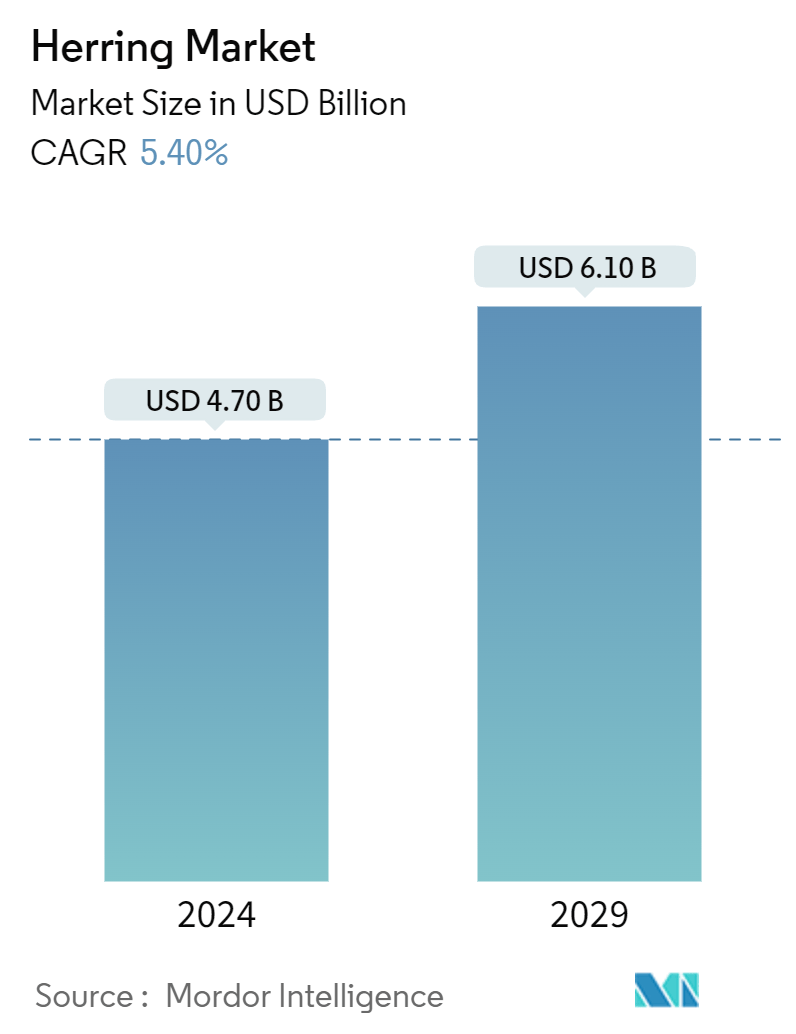Market Size of Herring Industry

| Study Period | 2019 - 2029 |
| Market Size (2024) | USD 4.70 Billion |
| Market Size (2029) | USD 6.10 Billion |
| CAGR (2024 - 2029) | 5.40 % |
| Fastest Growing Market | Asia Pacific |
| Largest Market | Europe |
Herring Market Analysis
The Herring Market size is estimated at USD 4.70 billion in 2024, and is expected to reach USD 6.10 billion by 2029, at a CAGR of 5.40% during the forecast period (2024-2029).
- Herring, a traditional delicacy in many Western countries including Poland, Russia, and Lithuania, has seen increased commercial demand due to urbanization, despite slow global market growth. Norway, the Netherlands, Denmark, and Iceland are the dominant players in the herring market, possessing large fishing industries capable of substantial export quantities. Iceland stands out as a leading exporter of frozen herrings, with exports valued at USD 18.4 million in 2023, according to the ITC Trade Map. The country's high export volume is attributed to its access to nutrient-rich North Atlantic waters, a well-managed quota system, and advanced fishing technologies. Iceland's emphasis on sustainable fishing practices, certified by the Marine Stewardship Council (MSC), appeals to environmentally conscious markets.
- Other significant players in the herring fishing industry include Russia, Japan, and Canada. Russia emerged as the largest exporter of frozen herrings in 2023, with exports valued at USD 175.5 million, according to the ITC Trade Map. Russia's success in this market is due to its extensive access to the Barents and Okhotsk Seas, which are abundant in herring populations. The country has developed large fishing fleets and processing facilities to maintain high production levels.
- The herring market is influenced by various factors, including supply and demand, environmental concerns, and consumer preferences. As a popular and versatile fish, herring is projected to remain an important part of the global seafood market contributing to the market's growth over the years.
Herring Industry Segmentation
Herring are small, silver-colored fish belonging to the family Clupeidae. These streamlined, schooling fish feed on plankton and inhabit both freshwater and saltwater environments. The global herring market is segmented geographically into North America, Europe, Asia-Pacific, South America, and Africa. This report analyzes production (volume), consumption (value and volume), export (value and volume), import (value and volume), and price trend analysis. The report offers market size and forecasts in volume (metric tons) and value (USD) terms across all segments.
| Geography (Production Analysis, Consumption Analysis by Value & Volume, Import Analysis by Value & Volume, Export Analysis by Value & Volume and Price Trend Analysis) | |||||||||
| |||||||||
| |||||||||
| |||||||||
| |||||||||
|
Herring Market Size Summary
The global herring market is experiencing a steady growth trajectory, driven by the increasing consumer preference for fish due to its health benefits, including high protein content and essential nutrients like Omega-3 fatty acids. Europe stands as the predominant consumer of herring, benefiting from its abundant availability in the North Atlantic, Baltic, and North Sea regions. The fish has been a staple in European diets for over two millennia, particularly in countries such as Poland, Russia, and Lithuania, where it is often served during significant cultural occasions. The market is further bolstered by urbanization, which has enhanced the commercial demand for herring. Key players in the industry include Norway, the Netherlands, Denmark, and Iceland, all of which have robust fishing industries capable of supplying substantial herring quantities for export. Additionally, countries like Russia, Japan, and Canada contribute significantly to the global herring fishing industry.
The rise of e-commerce in the fish marketplace is transforming the herring market, offering consumers the convenience of purchasing sustainably sourced seafood from home. Online platforms are increasingly partnering with small-scale fishermen and aquaculture producers who adhere to responsible fishing practices, thereby expanding their customer base. This shift is expected to further enhance the market's growth during the forecast period. Herring's nutritional benefits, such as improving heart health and providing essential vitamins and minerals, are driving its consumption worldwide, particularly in Europe, where it is valued for its affordability and versatility. The European market's dominance is supported by a well-established infrastructure for processing and distribution, alongside a strong culinary tradition that embraces herring. Despite the market's maturity in Europe, it is anticipated to continue growing steadily, with recent developments such as increased exports from Norway and international agreements on fishing quotas further supporting this trend.
Herring Market Size - Table of Contents
-
1. MARKET DYNAMICS
-
1.1 Market Overview
-
1.2 Market Drivers
-
1.2.1 Growing Demand for Fish Food Products
-
1.2.2 Government Initiatives to Increase Production
-
1.2.3 Technological Advancements in Fishing and Processing
-
-
1.3 Market Restraints
-
1.3.1 Stringent Fishing Regulations
-
1.3.2 Competition from Alternative Fish Species
-
-
1.4 Value chain Analysis
-
-
2. MARKET SEGMENTATION
-
2.1 Geography (Production Analysis, Consumption Analysis by Value & Volume, Import Analysis by Value & Volume, Export Analysis by Value & Volume and Price Trend Analysis)
-
2.1.1 North America
-
2.1.1.1 United States
-
2.1.1.2 Canada
-
2.1.1.3 Mexico
-
2.1.1.4 Rest of North America
-
-
2.1.2 Europe
-
2.1.2.1 United Kingdom
-
2.1.2.2 France
-
2.1.2.3 Denmark
-
2.1.2.4 Netherlands
-
2.1.2.5 Germany
-
2.1.2.6 Sweden
-
2.1.2.7 Rest of Europe
-
-
2.1.3 Asia-Pacific
-
2.1.3.1 China
-
2.1.3.2 India
-
2.1.3.3 Japan
-
2.1.3.4 Indonesia
-
2.1.3.5 Philippines
-
2.1.3.6 Rest of Asia-Pacific
-
-
2.1.4 South America
-
2.1.4.1 Brazil
-
2.1.4.2 Argentina
-
2.1.4.3 Rest of South America
-
-
2.1.5 Africa
-
2.1.5.1 Egypt
-
2.1.5.2 Rest of Africa
-
-
-
Herring Market Size FAQs
How big is the Herring Market?
The Herring Market size is expected to reach USD 4.70 billion in 2024 and grow at a CAGR of 5.40% to reach USD 6.10 billion by 2029.
What is the current Herring Market size?
In 2024, the Herring Market size is expected to reach USD 4.70 billion.

